

The Voluntary Carbon Market (VCM) is a bit of a wild west.
There, we said it.
It’s unregulated. There are no set guidelines or governance for creating a carbon project and selling carbon credits.
We do have private carbon standards – organisations like Verra, Gold Standard, and the American Carbon Registry. They’re doing great work, establishing the criteria and processes for verifying and certifying carbon projects to improve credibility.
But, all of these different standards have different eligibility criteria and focus areas, which can just serve to add to the confusion and complexity for carbon buyers looking for one source of truth to help them do the right thing.
So we’ve ended up with a complex, fragmented VCM which is flooded with low-quality carbon projects that aren’t actually making the real-world impact they claim to. And business offsetting has had a bad reputation because of that.
It’s not how it should be.
We need a VCM we can trust.
A VCM that enables the projects truly protecting nature and removing carbon from the atmosphere to get the vital finance they need to do their work – and preventing dodgy projects from benefiting. A VCM that enables businesses to account for their unavoidable or hard-to-abate emissions by buying credits from these projects with confidence, so that we can all meet our global net zero targets.
That’s why it’s so important that we improve the integrity of the VCM – and there are a number of initiatives which are aiming to do so, addressing the concerns outlined above and creating the guidelines and frameworks that will bring consistency, transparency, and trust.
Currently, there are two key standards which are gaining traction, and which will shape the future of carbon offsetting:
- The Integrity Council for the Voluntary Carbon Market (ICVCM)
- The Voluntary Carbon Markets Integrity Initiative (VCMI)
Let’s take a look at both of them.

The Integrity Council for the Voluntary Carbon Market (ICVCM)
What is the Integrity Council for the Voluntary Carbon Market (ICVCM)?
The Integrity Council for the Voluntary Carbon Market (ICVCM) is an independent body working to establish a set of global standards for a high-integrity Voluntary Carbon Market, ensuring the VCM contributes effectively towards the Paris Agreement climate goals. The ICVCM team includes a panel of both science and policy experts to ensure the standards they develop are rigorous, robust, and based on latest research.
The ICVCM has 3 core aims:
- To establish a set of ‘Core Carbon Principles’ (CCPs) which will be new standards for high-quality carbon credits – including guidelines on which carbon-crediting programmes and project methodologies are accepted under these CCPs.
- To govern and oversee standard-setting organisations and carbon-crediting programmes to ensure adherence to the CCPs.
- To help coordinate and manage connections between other bodies working on the responsible growth of the Voluntary Carbon Market, and define a roadmap for this.
So far, the focus has been on developing the Core Carbon Principles.
In July 2022 the ICVCM published a draft set of the Core Carbon Principles and Assessment Framework for programmes to be assessed for their alignment to the Principles, which was open for consultation until September 2022.
In March 2023 the finalised version of the Core Carbon Principles and the first part of the Assessment Framework was published.
In mid 2023 it's expected that the remaining part of the Assessment Framework will be released (giving the category specific assessment process), at which point carbon-crediting programmes will be invited to be assessed under the CCPs.
We’ll keep this article updated as this progresses, so keep it bookmarked – or you can also sign up to our monthly newsletter to get the latest straight to your inbox.
For now, let’s explore what the current Core Carbon Principles include.
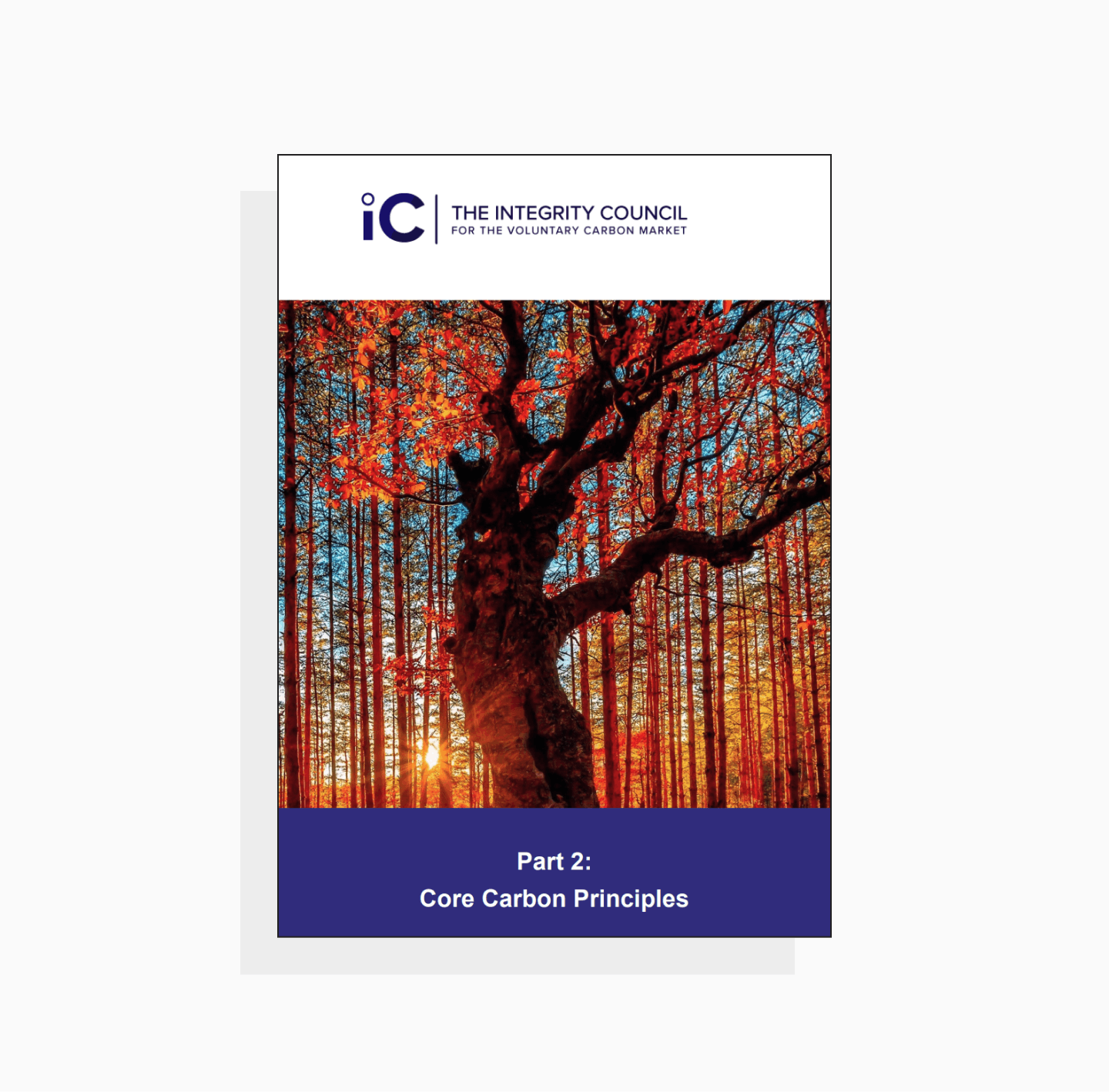
What are the ICVCM Core Carbon Principles?
The ICVCM’s draft Core Carbon Principles consist of 10 principles, through which the integrity and quality of a carbon credit can be determined.
The 10 Core Carbon Principles are split up into 3 sections, as follows:
A Governance
1. Effective governance: the program responsible for carbon-crediting for the project must have effective governance to ensure transparency, accountability, and quality of the carbon credits issued. This includes publicly available documentation, clear roles and responsibilities, transparency regarding decision-making processes, legal procedures, public engagement, and more.
2. Tracking: the program responsible for carbon-crediting for the project must operate or use a registry which enables carbon credits to be uniquely identified, recorded, and tracked.
3. Transparency: the program responsible for carbon-crediting for the project must provide comprehensive and transparent information on all credited mitigation activities. The information shall be publicly available in electronic format and shall be accessible to non-specialised audiences, to enable scrutiny of mitigation activities.
4. Robust independent third-party validation and verification: the program responsible for carbon-crediting for the project must have requirements for the verification of the project’s activity to reduce or remove carbon emissions through a trusted independent, third-party.
B Emissions impact
5. Additionality: the carbon emissions reduced or removed by the project’s activity must be additional i.e. they wouldn’t have happened if the project was not able to sell carbon credits. Learn more about additionality in offsetting.
6. Permanence: the carbon emissions reduced or removed by the project’s activity must be permanent, or if there is a risk of the benefit being reversed then this reversal risk must be fully accounted for through a) robust monitoring and/or b) compensation via a buffer. Learn more about permanence in offsetting.
7. Robust quantification of emissions reductions or removals: the carbon emissions reduced or removed by the project’s activity must be correctly quantified using accepted scientific methods. This quantification should be conservative to account for any inevitable uncertainties. Learn more about quantifying impact (and avoiding over-estimation of impact) in offsetting.
8. No double counting: the carbon emissions reduced or removed by the project’s activity must be counted only once towards meeting climate targets (including double issuing, double claiming, and double use). Learn more about double counting in offsetting.
C Sustainable development
9. Sustainable development benefits and safeguards: the program responsible for carbon-crediting for the project must have clear guidance, tools, and compliance procedures to ensure that the project’s activity aligns with (or goes beyond) best practice on social and environmental safeguards for carbon projects, and creates net positive sustainable development impacts. This includes the project’s approach to assessing environmental risks, engaging with local communities, fair employment practices, acquiring land, gender equality, benefit-sharing mechanisms and more. Learn more about co-benefits in offsetting.
10. Contribution toward net zero transition: the project’s activity must not lock in practices or technologies that are incompatible with the transition to a net zero society by 2050.
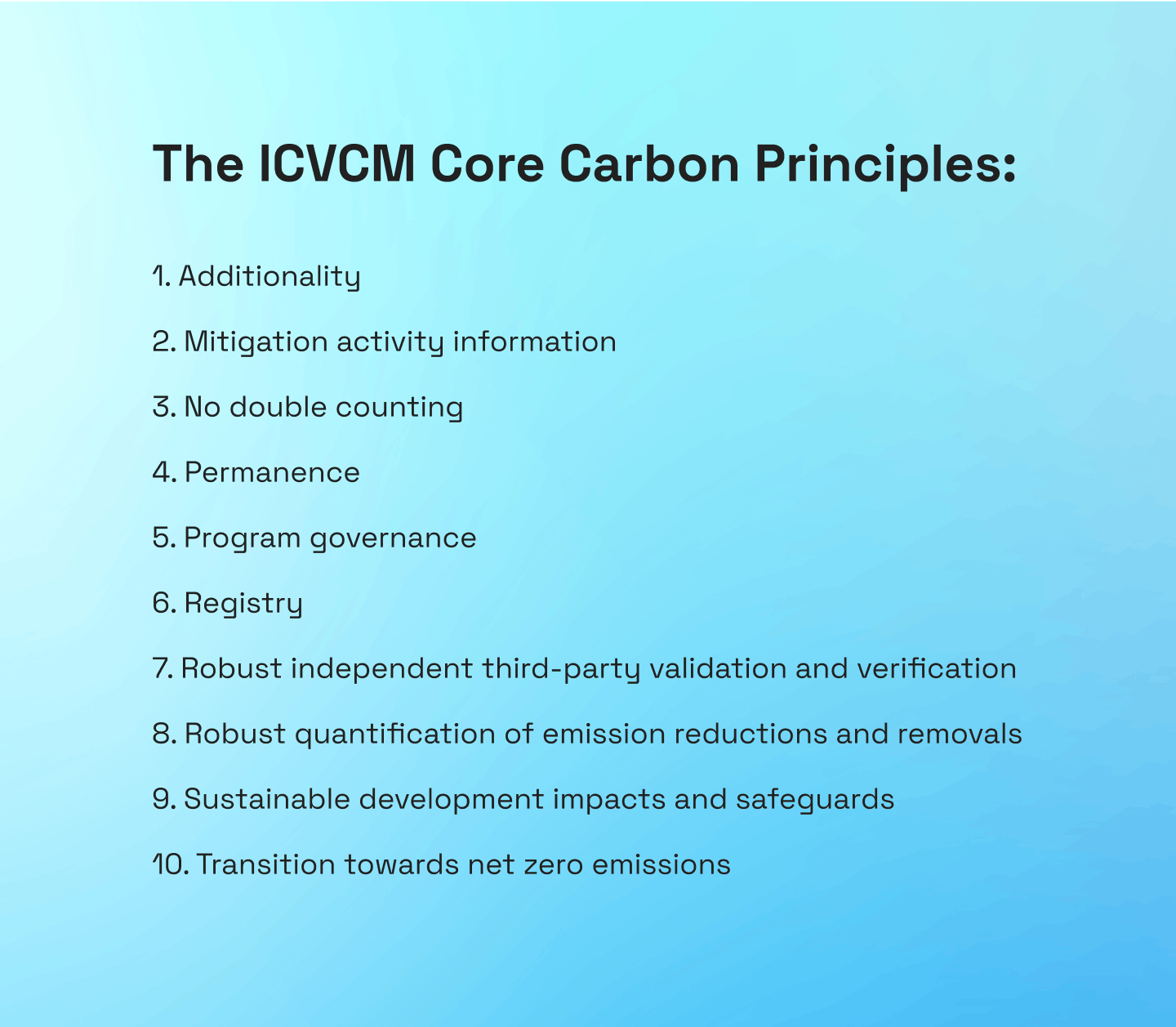
For more detail on the Core Carbon Principles, head to the ICVCM’s website – particularly we’d recommend taking a look at the Assessment Framework, which provides much more information on what carbon projects and the carbon-crediting programme they work with will need to do to adhere to the CCPs.
Later this year, carbon-crediting programmes will be invited to be assessed to check that they (and the carbon projects they verify) are compliant with the CCPs – and from this we should start to see more consistency and uniformity in how carbon projects are checked for quality.
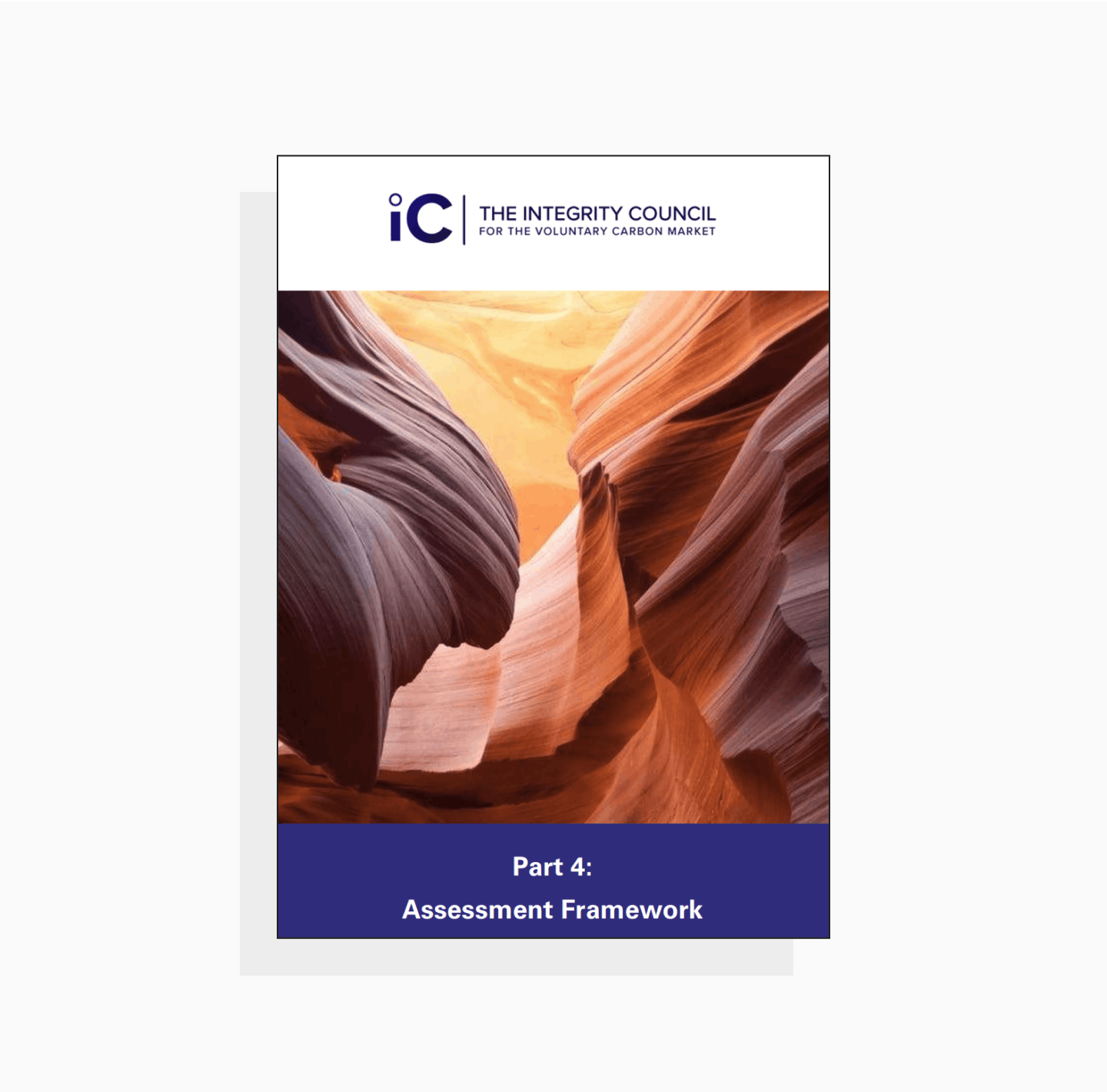
The Voluntary Carbon Markets Integrity Initiative (VCMI)
What is the Voluntary Carbon Markets Integrity Initiative (VCMI)?
The Voluntary Carbon Markets Integrity Initiative (VCMI) is an independent body established to ensure confidence that the claims made by buyers of carbon credits on the Voluntary Carbon Market have integrity and can be trusted. VCMI is backed by the UK Government and is supported by an expert advisory panel.
So, whereas the ICVCM focuses on the seller side of the Voluntary Carbon Market (i.e. the integrity of the carbon projects and carbon credits themselves), the VCMI focuses on the buyer side (i.e. the integrity of the claims made by individuals and businesses buying carbon credits).
The VCMI has two initial priorities:
- Develop high integrity guidance for buyers of carbon credits, including on climate claims by businesses.
- Support access to high-integrity voluntary carbon markets and monitor broader supply-side integrity efforts.
Their first publication is the VCMI Claims Code of Practice (COP).
What are the VCMI Claims Code of Practice?
The VCMI Claims Code of Practice (CoP) is a set of guidelines to ensure that the claims by those buying carbon credits on the VCM are of high integrity.
Essentially, the Code aims to give companies (and other carbon buying entities) confidence in how to buy carbon credits in the VCM with confidence about their credibility. Through this, there will also be improved transparency and trust around the carbon offsetting claims made by companies – with many questionable, poorly substantiated claims currently being made which may not be helping us collectively progress towards global climate targets.
The VCMI published their provisional Claims Code of Practice in June 2022, with road testing and public consultation through to August 2022. The finalised CoP is due to be published in early 2023 – and we’ll keep this article updated as progress arises.
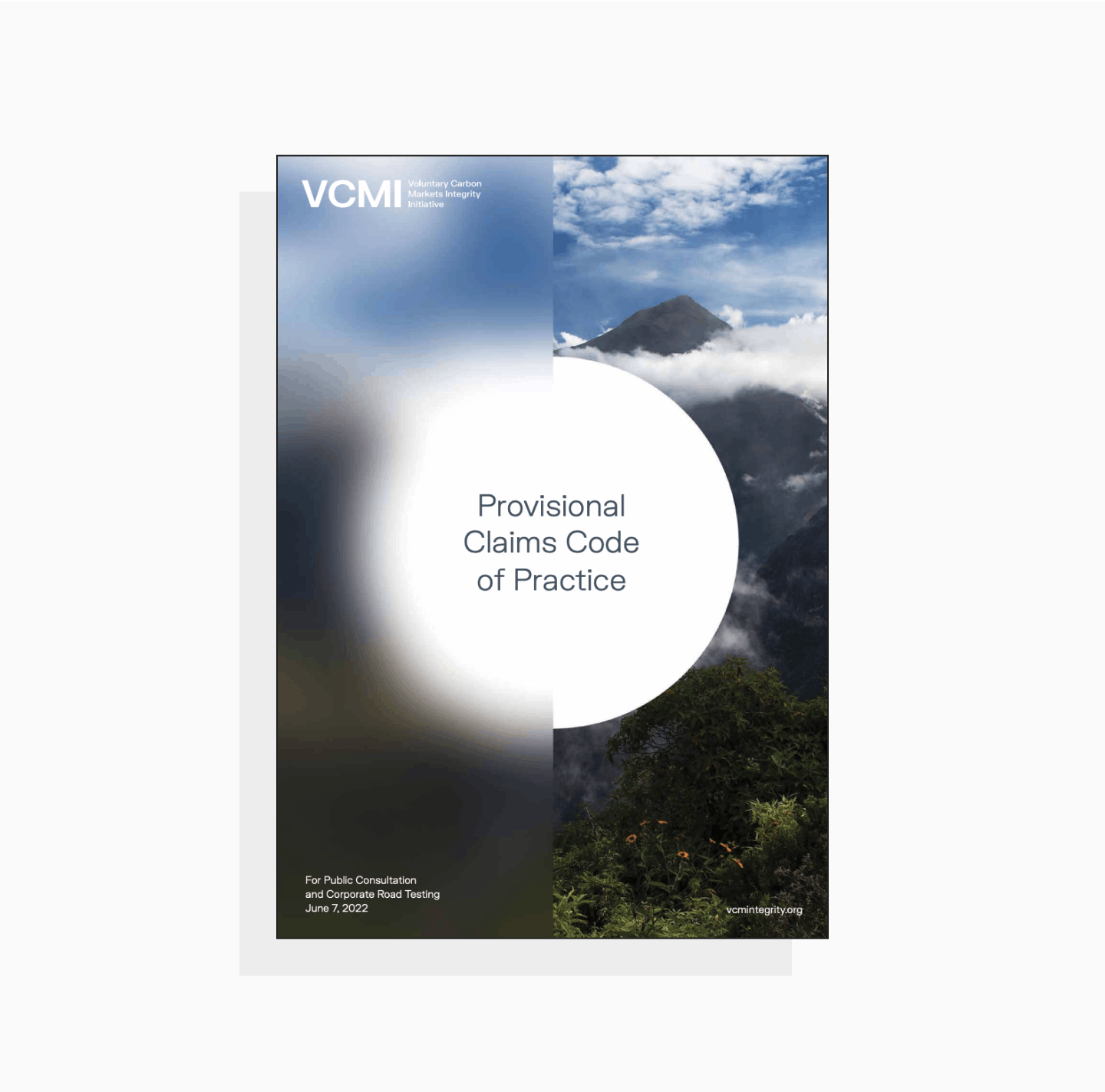
There are two main parts of the provisional CoP to understand:
- 4 steps for making ‘credible claims’ i.e. using carbon credits as part of meaningful climate commitments.
- Criteria rating the climate claims of organisations as bronze, silver, or gold.
The 4 steps for companies to make credible claims under the CoP are:
- Meet the prerequisites: companies must only buy carbon credits in addition to science-aligned decarbonisation plans for their own value chains, not as a substitute for direct action themselves. This includes making a public commitment to achieve net zero by 2050, setting interim emission reductions targets, providing detailed information on their plans to meet those targets, and more.
- Identify claims to make: claims made under the CoP can either be ‘enterprise-wide claims’ i.e. for the entire organisation or ‘brand, product, and service-level claims’ i.e. for a specific product or brand – for example a company could be claiming they are net zero as an entire company, or that one of their products is net zero.
- Purchase high-quality credits: all credits purchased as a basis for making a climate claim must be high-quality. The VCMI does not give guidance itself on what this should look like, but the CoP does reference the work of the ICVCM which we outlined earlier – so you can see how the two go hand-in-hand in building the integrity of the VCM.
- Report transparently on the use of credits: companies should have publicly available, detailed information about their claim(s) – including the prerequisites from step 1, as well as how they are using carbon credits towards their climate targets, and detailed information about the carbon credits they have purchased.
All actions towards these steps must also be checked and confirmed by a trusted, independent third-party.
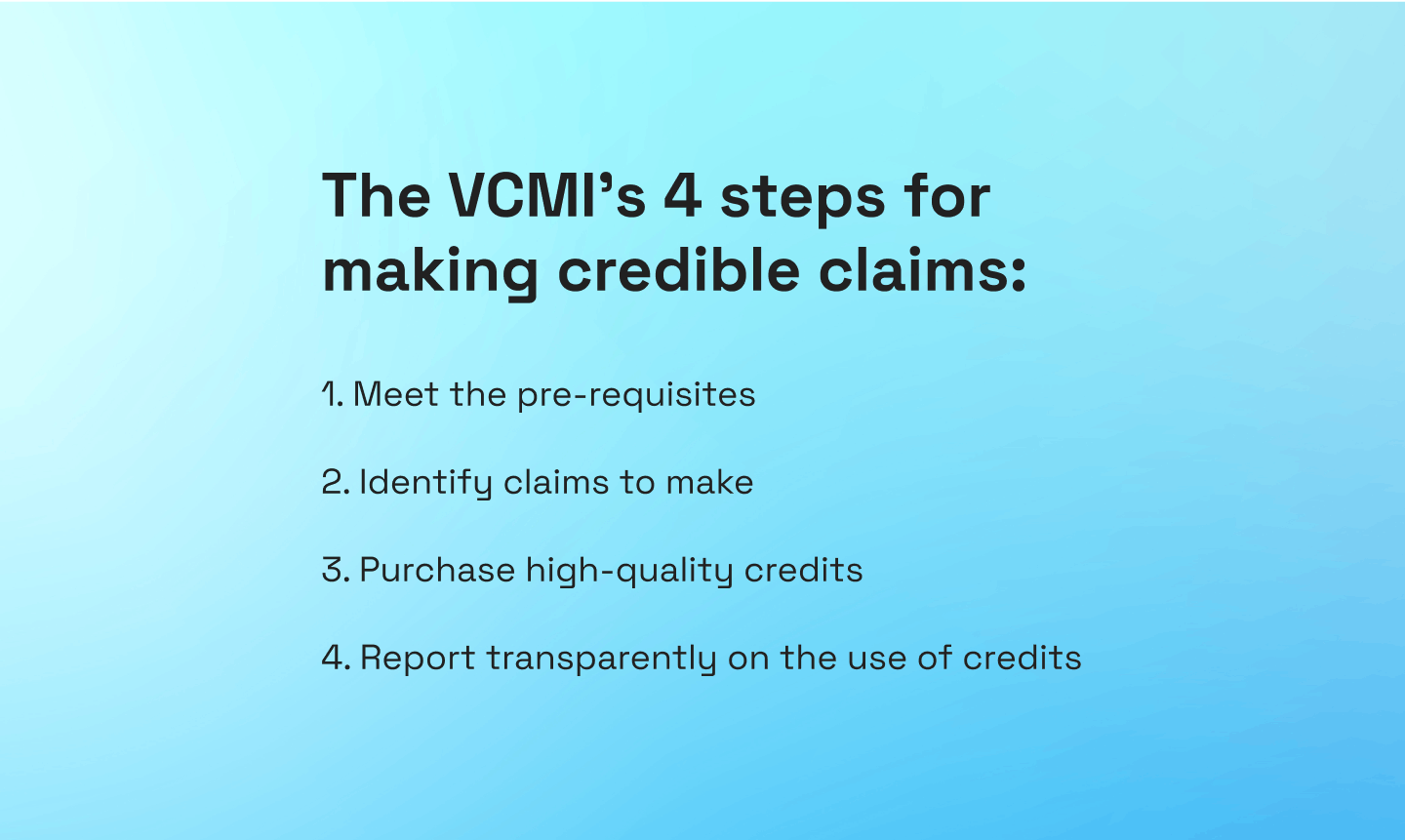
And the claims will be rated as bronze, silver, or gold, based on the following criteria.
Bronze (only available until 2030):
- The emissions reductions required for the company to meet its interim climate targets are on track across scope 1 and 2 emissions
- Emissions reductions are partially on track for scope 3 emissions with high-quality carbon credits purchased to compensate for up to 50% of the remaining unabated scope 3 emissions to the level of the interim targets – with the proportion covered by carbon credits reducing year on year. This is accepted only until 2030.
- Any remaining emissions beyond the interim targets are at least 20% compensated in the first year through the purchase of high-quality carbon credits – with this increasing over time.
Silver:
- Emissions reductions required for the company to meet its interim climate targets are on track across all of scope 1, 2, and 3 emissions
- Any remaining emissions beyond those targets are at least 20% compensated in the first year through the purchase of high-quality carbon credits – with this increasing over time.
Gold:
- Emissions reductions required for the company to meet its interim climate targets are on track across all of scope 1, 2, and 3 emissions
- Any remaining emissions beyond those targets are 100% compensated for through the purchase of high-quality carbon credits.
For more detailed information, go to the VCMI Provisional Claims Code of Practice
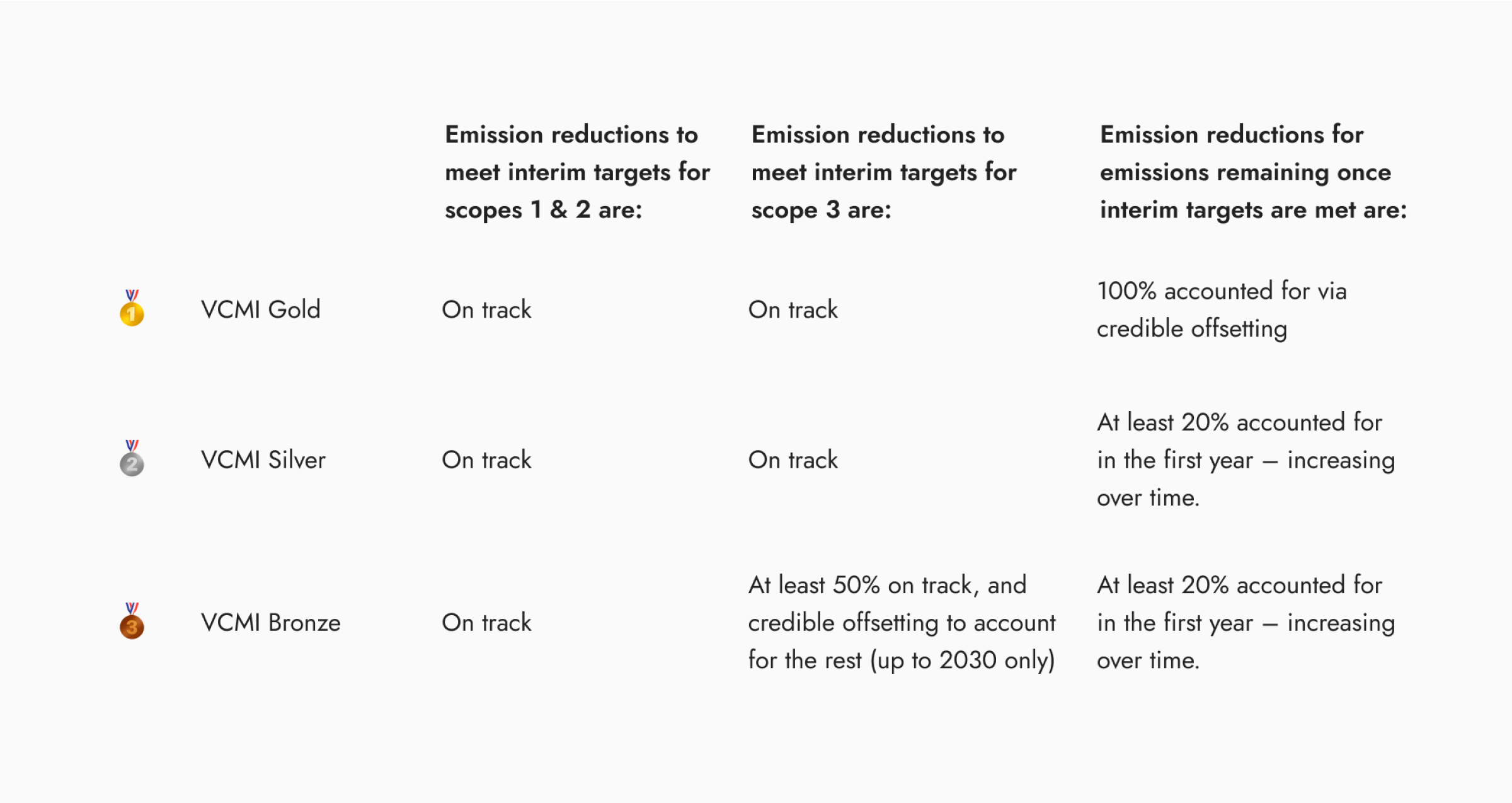
In summary...
Combined, the guidelines under development by the ICVCM and VCMI promise to increase integrity within the Voluntary Carbon Market – raising confidence and consistency in the quality and real-world impact of the carbon credits we buy, as well as raising confidence and consistency in the climate claims that companies who buy those carbon credits make.
So, if you’re looking for guidance on bringing credible and impactful carbon offsetting into your corporate climate commitments, we’d highly recommend getting familiar with these guidelines – as well as two other best-in-class initiatives bringing credibility to the world of business carbon offsetting, the Oxford Offsetting Principles and Science Based Targets.
Readers also liked
Readers also liked

Subscribe for emissions intelligence insights
Get the latest updates in the world of carbon tracking, accounting, reporting, and offsetting direct to your inbox.


